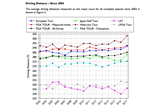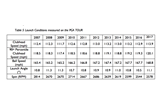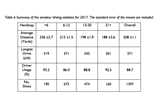Your six takeaways from the 2017 Driving Distance Report
Last updated:
The R&A and USGA have released their 2017 Distance Report on hitting distances in the game, acknowledging the level of increase across the tours “is unusual and concerning”.
Ever read War and Peace? If you haven’t, the Rules on Golf will serve as a good starter pack. It’s long. Very long. Not to mention it takes an age to digest. So, you can imagine the apprehension when we waded through the R&A and USGA annual Driving Distance Report.
Hundreds of facts and figures, condensed into 24 pages and covering all seven worldwide tours and the amateur game. Luckily for you, we’ve pulled out the key stats so you can compare your swing and driving distance against the pros and players of a similar handicap.
Oh, and you can also find out how the R&A intends to tackle the advancements in technology and a “concerning” increase in driving distances. It’s a topic that has been much discussed in 2018, with more than 73 drives on the PGA Tour recorded over 400 yards this year alone. This is a stark increase to the 29 recorded in 2017, 8 in 2016 and 17 in 2015. And it’s only March. But how are they going to tackle it this discussion? Their answer may surprise you…
1. Pro golfers are hitting the ball further than ever before
It’s true. Pro golfers are hitting the ball further than ever before on each of the men’s tours. More than a third of tee shots measured on the European Tour and PGA Tour broke the 300-yard barrier in 2017, and 69 players and counting are already averaging beyond that mark on the PGA Tour this year. In total, the average driving distance on the mens’ tours has increased by roughly 2.2% from 2003 to 2017.
European Tour 2017
300-320 yards: 22.47%
320+ yards: 11.89%
European Tour 2003
300-320 yards: 17.07%
320+ yards: 9.07%
PGA Tour 2017
300-320 yards: 24.71%
320+ yards: 11.87%
PGA Tour 2003
300-320 yards: 18.79%
320+ yards: 7.77%
Tony Finau currently leads the PGA Tour driving distance stats with an average of 323.7 yards in the 2017/18 season.
2. An increase in distance is consistent across all seven worldwide tours
Monster drives are not just confined to the European Tour and PGA Tour. A three-yard gain was recorded across all seven worldwide tours, with pros on the Web.com Tour hitting 6.9 yards further than in 2016, and 10 yards longer than in 2003 – the largest overall increase in driving distance. Proof, perhaps, that being armed with the latest clubs and balls is more important than having an extra Weetabix for breakfast.
Driving Distance on the European Tour
2017: 291.7 yards
2016: 288.1 yards
2003: 286.3 yards
Driving Distance on the PGA Tour
2017: 292.5 yards
2016: 290 yards
2003: 285.9 yards
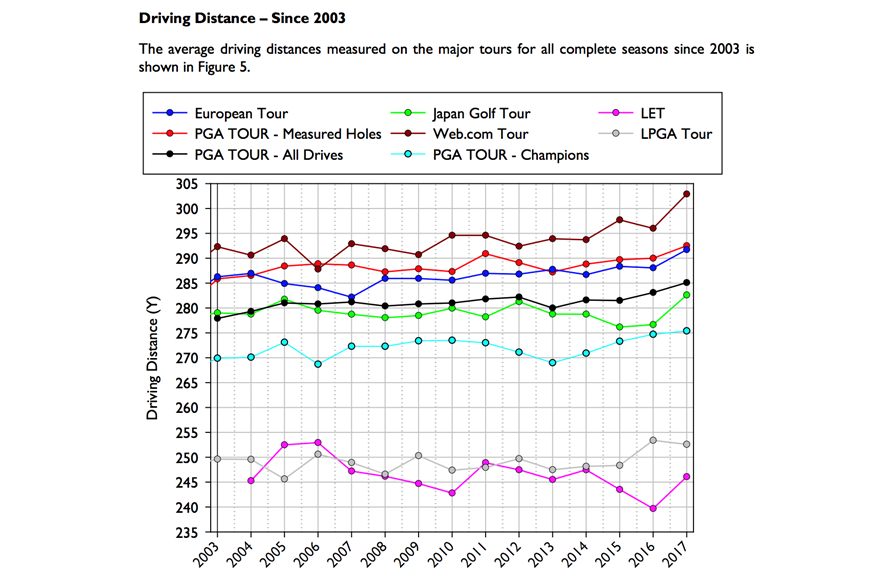
3. Dialling back the distance the golf ball travels won’t be happening just yet
Both Jack Nicklaus and Tiger Woods are among the game’s big names who have called for the distance the golf ball flies to be dialled back, and after R&A Chief Executive Martin Slumbers recently admitted that ‘a serious discussion’ about hitting distances was needed, it was speculated that this report would entail authoritative action.
However, that isn’t going to happen in regard to the golf ball any time soon. Under current circumstances, “the R&A and the USGA are not advocating that the Rules relating to golf ball specifications be changed.” Augusta National may think differently, though.
4. Don’t expect a new set of rules on equipment for pros
Last month, Slumbers said “There’s no doubt in my mind that the technology has made this difficult game just a little bit easier. At a time when we want more people to play the game, I think that’s a good thing. But we do also think that golf is a game of skill and should be reflective of skill. If you look at the data, there has been a significant move up across all tours. We’re looking at the longest on-record average driving distance. Both of those have caused us and our colleagues at the USGA serious concern.”
As it transpires however, the R&A and USGA note in the report that they regard separate rules for elite competitions “as undesirable and have no current plans to create separate equipment rules for highly-skilled players.”
They do, however, intend to “bring forward proposals designed to improve procedures for the approval of new products.” We doubt many manufacturers will be too happy about that!
5. The average driving distance of UK golfers are probably lower than you think
Good news. We can now measure our driving distance against people with the same handicap. Last year, 1,397 tee shots from club golfers in the UK were tracked and the average (mean) distances broken down into four handicap categories. The overall results show a typical amateur golfer averages 208 yards off the tee, which is just four yards less than an eight handicapper. That should make you feel better.
Average driving distance (yards)
Handicap <6: 236
Handicap 6-12: 212
Handicap 13-20: 198
Handicap 21+: 188
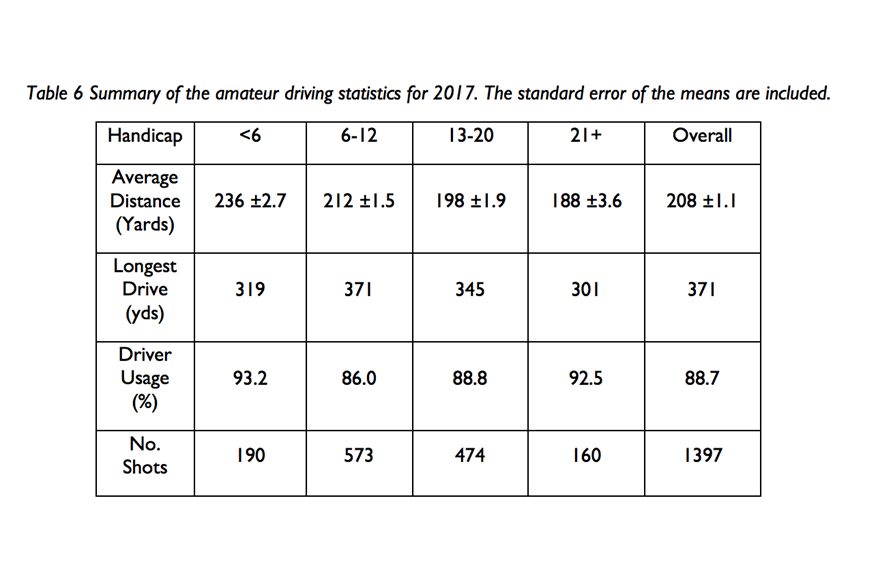
6. You can now compare yourself to the pro’s
Thanks to TrackMan data, we now know what numbers the average player on the PGA Tour clocked last season. Good luck achieving the same ball and clubhead speed!
Clubhead speed: 113.9 mph
Average launch angle: 11.1°
Average spin: 2,578 rpm
Ball speed: 168.8



